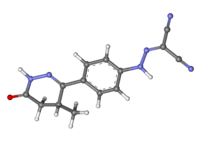Levosimendan
 | |
|---|---|
 | |
| Systematic (IUPAC) name | |
| ({4-[(4'R)-4-Methyl-6-oxo-1,4,5,6-tetrahydropyridazin-3-yl]phenyl}hydrazono)propanedinitrile | |
| Clinical data | |
| AHFS/Drugs.com | International Drug Names |
| Pregnancy cat. | no data |
| Legal status | Prescription only. Not marketed in the U.S. |
| Routes | IV |
| Pharmacokinetic data | |
| Bioavailability | 85% (oral) |
| Metabolism | hepatic |
| Half-life | 1 hour |
| Excretion | renal |
| Identifiers | |
| CAS number | 141505-33-1 |
| ATC code | C01CX08 |
| PubChem | CID 3033825 |
| DrugBank | DB00922 |
| ChemSpider | 2298414 |
| UNII | C6T4514L4E |
| KEGG | D04720 |
| ChEBI | CHEBI:50567 |
| ChEMBL | CHEMBL313136 |
| Chemical data | |
| Formula | C14H12N6O |
| Mol. mass | 280.28 |
| SMILES
| |
| |
| | |
Levosimendan (INN) /ˌliːvoʊsaɪˈmɛndən/ is a calcium sensitiser used in the management of acutely decompensated congestive heart failure. It is marketed under the trade name Simdax (Orion Corporation).
Mode of action
Levosimendan is a calcium sensitiser – it increases the sensitivity of the heart to calcium, thus increasing cardiac contractility without a rise in intracellular calcium. Levosimendan exerts its positive inotropic effect by increasing calcium sensitivity of myocytes by binding to cardiac troponin C in a calcium-dependent manner. It also has a vasodilatory effect, by opening adenosine triphosphate (ATP)-sensitive potassium channels in vascular smooth muscle to cause smooth muscle relaxation. The combined inotropic and vasodilatory actions result in an increased force of contraction, decreased preload and decreased afterload. Moreover, by opening also the mitochondrial (ATP)-sensitive potassium channels in cardiomyocytes, the drug exerts a cardioprotective effect.
Clinical use
Indications
Levosimendan is indicated for inotropic support in acutely-decompensated severe congestive heart failure.
Some of the Phase III studies in the extensive clinical program were the trials LIDO (200 patients), RUSSLAN (500), CASINO (250), REVIVE-I (100), REVIVE-II (600) and finally SURVIVE (1350),[1] a head-to-head trial between levosimendan and dobutamine in acute decompensated heart failure. In total, the clinical data base includes more than 3500 patients in Phase IIb and III double-blind studies, which is the highest number ever in testing a drug for acute decompensated heart failure.[citation needed]
Despite an initial reduction in plasma B-type natriuretic peptide level in patients in the levosimendan group compared with patients in the dobutamine group in a head to head comparison study, levosimendan did not significantly reduce all-cause mortality at 180 days.[1] However, the drug was proven to be superior to dobutamine for treating patients with a history of CHF or those on beta-blocker therapy when they are hospitalized with acute decompensations (Mebazaa et al. Eur J Heart Fail 2009 11:304-11)
In a meta-analysis of randomized controlled studies by Zangrillo et al. levosimendan is shown to reduce cardiac troponin release after cardiac surgery when used pre- and peri-operatively.[2]
Licensing status
The Orion Corporation originally developed levosimendan and applied for a new drug application in 1998 in the U.S. However the Food and Drug Administration (FDA) requested further trials be conducted and Orion withdrew the application in November 1999. Orion were successful at obtaining approval to market the drug in Sweden in 2000. Since then around 55 other countries worldwide have approved the drug but it remains unlicensed in the US.[3]
Contraindications
The use of levosimendan is contraindicated in patients with: moderate-to-severe renal impairment, severe hepatic impairment, severe ventricular filling or outflow obstruction, severe hypotension and tachycardia, and/or history of torsades de pointes.[4]
Adverse effects
Common adverse drug reactions (≥1% of patients) associated with levosimendan therapy include: headache, hypotension, arrhythmias (atrial fibrillation, extrasystoles, atrial tachycardia, ventricular tachycardia), myocardial ischaemia, hypokalaemia and/or nausea (Rossi, 2006).
Formulations
Levosimendan is marketed as a 2.5 mg/mL concentrated solution for IV infusion. The concentrate is diluted with glucose 5% solution before infusion.
References
- ↑ 1.0 1.1 Mebazaa, A; Nieminen MS, Packer M, Cohen-Solal, Kleber FX, Pocock SJ, Thakkar R, Padley RJ, Poder P, Kivikko M for the SURVIVE investigators (2007). "Levosimendan vs dobutamine for patients with acute decompensated heart failure". JAMA 297 (17): 1883–91. doi:10.1001/jama.297.17.1883. PMID 17473298.
- ↑ Landoni, G; Mizzi, A; Biondi-Zoccai, G; Bruno, G; Bignami, E; Corno, L; Zambon, M; Gerli, C et al. (2010). "Reducing mortality in cardiac surgery with levosimendan: A meta-analysis of randomized controlled trials". Journal of cardiothoracic and vascular anesthesia 24 (1): 51–7. doi:10.1053/j.jvca.2009.05.031. PMID 19700350.
- ↑ Orion. "Simdax (levosimendan) Fact Sheet". Orion. Retrieved 16 February 2013.
- ↑ Rossi S, editor. Australian Medicines Handbook 2006. Adelaide: Australian Medicines Handbook; 2006.
| |||||||||||||||||||||||||||||||||||